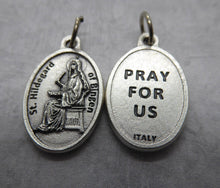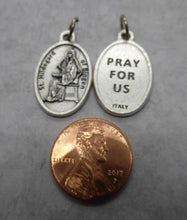Hildegard von Bingen (1098-1179) silver oxide holy medal
Memorial is September 17.
At a time when few women wrote, Hildegard produced major works of theology and visionary writings. When few women were respected, she was consulted by and advised bishops, popes, and kings. She used the curative powers of natural objects for healing, and wrote treatises about natural history and the medicinal uses of plants, animals, trees and stones. She is the first musical composer whose biography is known. She founded a vibrant convent, where her musical plays were performed. Interest in this extraordinary woman was initiated by musicologists and historians of science and religion. Unfortunately, Hildegard’s visions and music have been hijacked by the New Age movement; New Age music bears some resemblance to Hildegard’s ethereal airs. Her story is important to students of medieval history and culture, and an inspirational account of an irresistible spirit and vibrant intellect overcoming social, physical, cultural, gender barriers to achieve timeless transcendence.
Hildegard was the tenth child born to a noble family. As was customary with the tenth child, which the family could not count on feeding, and who could be considered a tithe, she was dedicated at birth to the Church. The girl started to have visions of luminous objects at the age of three, but soon realized she was unique in this ability and hid this gift for many years.
At age eight her family sent Hildegard to an anchoress named Jutta to receive a religious education. Jutta was born into a wealthy and prominent family, and by all accounts was a young woman of great beauty who had spurned the world for a life decided to God as an anchoress. Hildegard’s education was very rudimentary, and she never escaped feelings of inadequacy over her lack of schooling. She learned to read Psalter in Latin, but her grasp of Latin grammar was never complete (she had secretaries help her write down her visions), but she had a good intuitive feel for the intricacies of the language, constructing complicated sentences with meanings on many levels and which are still a challenge to students of her writing. The proximity of the Jutta’s anchorage to the church of the Benedictine monastery at Disibodenberg exposed Hildegard to religious services which were the basis for her own musical compositions. After Jutta’s death, when Hildegard was 38 years of age, she was elected the head of the budding convent that had grown up around the anchorage.
During the years with Jutta, Hildegard confided of her visions only to Jutta and a monk named Volmar, who was to become her lifelong secretary. However, in 1141 a vision of God gave Hildegard instant understanding of the meaning of religious texts. He commanded her to write down everything she would observe in her visions.
And it came to pass…when I was 42 years and 7 months old, that the heavens were opened and a blinding light of exceptional brilliance flowed through my entire brain. And so it kindled my whole heart and breast like a flame, not burning but warming…and suddenly I understood of the meaning of expositions of the books…
Yet Hildegard was also overwhelmed by feelings of inadequacy and hesitated to act.
But although I heard and saw these things, because of doubt and low opinion of myself and because of diverse sayings of men, I refused for a long time a call to write, not out of stubbornness but out of humility, until weighed down by a scourge of god, I fell onto a bed of sickness.
Though she never doubted the divine origin of her visions, Hildegard wanted them to be approved by the Church. She wrote to Saint Bernard who took the matter to Pope Eugenius who exhorted Hildegard to finish her writings. With papal imprimatur, Hildegard finished her first visionary work Scivias (“Know the Ways of the Lord“) and her fame began to spread through Germany and beyond.
The 12th century was also the time of schisms and religious confusion when anyone preaching any outlandish doctrine could attract a large following. Hildegard was critical of schismatics, and preached against them her whole life, working especially against the Cathari.
Declared a Doctor of the Church on 7 October 2012 by Pope Benedict XVI. (info from CatholicSaints.Info » Blog Archive » Saint Hildegard von Bingen)
- Catholic Saint - Sybil of the Rhine, Doctor of the Church
Natural Medicine, Visionary, Music Composer.
These medals are great on necklaces, bracelets, rosaries, pins or whatever else you had in mind. They all come with an open jump ring so you can attach it to your necklace.
Get a chain here:
Holy Medal Chains - 18", 24", 30" chains, stainless steel, aluminum, c – chillypumpkinholymedals
All medals and crucifixes are silver oxide (unless noted otherwise), which is a silver plated zinc alloy. **For the longest shine, you may want to coat your silver oxide medals with a clear coat of clear nail polish. The thin coating of silver oxide will eventually wear off.** They are quality Italian made, and the medals are approx. 1 inch tall and 5/8 inch wide.
Your items will ship first class within 1-3 days, in a padded kraft envelope.






